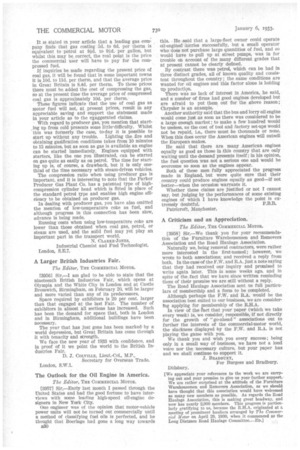The Editor, THE COMMERCIAL MOTOR.
Page 43

Page 44

If you've noticed an error in this article please click here to report it so we can fix it.
[3955] Sir,—I have read with considerable interest the article in your issue of December 16 dealing with gas as an alternative fuel, and endorse your conclusion that many exaggerated claims are being made in
regard to coal gas. B29 It is stated in your article that a leading gas company finds that gas costing 5d. to 6c1. per therm is equivalent to petrol at 81d. to 91d. per gallon, but whilst this may be correct, the real point is the price the commercial user will have to pay for the compressed fuel.
If inquiries be made regarding the present price of coal gas, it will be found that in some important towns it is 10d. to lid, per therm, and that the average price in Great Britain is 8.4d. per therm. To these prices there =tat be added the cost of compressing the gas, so at the present time the average price of compressed coal gas is approximately 10d. per therm.
These figures indicate that the use of coal gas as motor fuel will not, at present prices, result in any appreciable saving and support the statement made in your article as to the epggerated With regard to producer gas, you mention that starting up from cold presents some little' difficulty. Whilst this was formerly, the case, to-day it is possible to start up without any trouble. Lighting the fire and obtaining gasification conditions takes from 10 minutes to 15 minutes, but as soon as gas is available an engine can be started immediately. Engines equipped with starters, like the one you illustrated, can be started on gas quite as easily as on petrol. The time for starting up is, of course, a drawback, but it is only onethird of the time necessary with steam-driven vehicles.
The compression ratio when using producer gas is Important, and it is interesting to note that the Parker Producer Gas Plant Co. has a patented type of highcompression cylinder head which is fitted in place of the standard petrol type and enables high engine efficiency to be obtained on producer gas.
In dealing with producer gas, you have also omitted the mention of low-temperature coke as fuel, and although progress in this connection has been slow, advance is being made.
Running costs when using low-temperature coke are lower than those obtained when coal gas, petrol, or steam are used, and the solid fuel may yet play an important part in the transport world.
N. CLARKE-JONES, Industrial Chemist and Fuel Technologist. London, S.E.7.




























































































